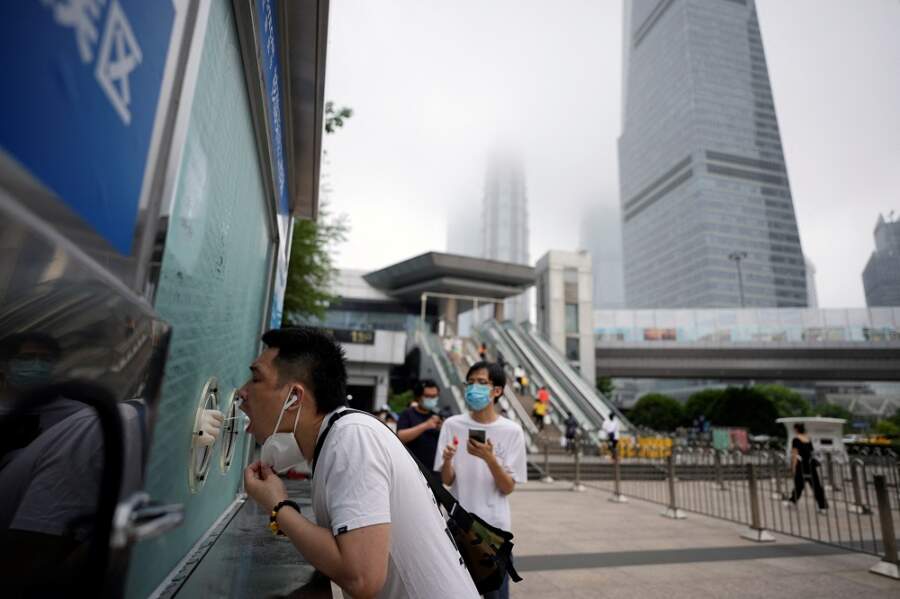
By Brenda Goh and Andrew Galbraith
SHANGHAI (Reuters) -Shanghai residents’ relief over the easing of a two-month COVID-19 lockdown is giving way to frustration as they face hours waiting in line for virus tests and must show negative results to be permitted to enter public spaces.
China’s biggest city and business hub lifted lockdowns for most of its 25 million residents on Wednesday. But citizens are required to have proof they have taken a COVID test within the last 72 hours in order to enter areas like malls and offices – or even to use subways and buses.
Authorities have built 15,000 testing sites and trained thousands of workers to swab throats. Still, long queues amid early summer heat became a common sight on Wednesday and Thursday, with some people saying they queued for two hours.
One picture posted on social media showed a sign at a booth warning of a 4-and-a-half hour wait.
“I left the lockdown nightmare only to enter the 72-hour PCR testing nightmare,” said one Shanghai resident on Weibo, declining to provide her name.
“It is troublesome, but we have no choice,” said another, named Xu Xiaojun. “This is for everyone’s good.”
Xia Kejia, a city official responsible for PCR screening, apologised for the queues at a news conference on Thursday and said more workers would be deployed and booths’ opening times extended to try to resolve the issues.
Other cities including Beijing and Shenzhen have imposed similar requirements under a national zero-COVID policy that aims to cut off every infection chain.
Despite the discontent caused by Shanghai’s stringent curbs, China has vowed to stick with its approach. It says the zero-COVID policy is needed to save lives and prevent its healthcare system from being swamped, even as much of the world tries to return to normal despite ongoing infections.
That increasingly means COVID testing is becoming a feature of daily life. China’s goal is to have testing sites within a 15 minute walk for everyone in large cities.
The ruling Chinese Communist Party’s People’s Daily newspaper published a commentary on Thursday in which it said the zero-COVID policy was most appropriate for China’s situation. It also carried a front-page article describing how Shanghai was returning to normal.
“Great, phased results have been achieved in the defence of Shanghai,” it said.
ON EDGE
Still, some 2.5 million in the city remain under lockdown and the consequences of testing positive are the same as before. All positive cases will be sent to central quarantine and close contacts – including neighbours – barred from leaving home.
This has left many Shanghai residents remaining on edge. Two told Reuters that they were informed on Thursday by their compounds that they were required to go back under lockdown and undergo daily testing.
On Thursday, videos shared on social media showed people fleeing the luxury International Finance Centre (IFC) mall in the Lujiazui financial district after it stopped people from entering or exiting – a common practice at venues when a positive COVID test result is found.
The IFC mall later issued a notice saying that it had reopened at 12.30 p.m. local time after carrying out a full disinfection without confirming whether there had been a positive COVID test at the site. The mall did not respond to calls seeking further comment.
Other residents still under lockdown expressed mounting frustration over their situation.
Aden Hogan, a British citizen, said his Shanghai compound had not been released as two “abnormal” test results had been found among his neighbours this week. While they were later told that these were false positives, they were still being made to undergo multiple tests and not allowed to leave, he said.
“People have done nothing wrong. We’ve taken the test anytime that they have said…and they’ve been forcing us to have tests in the middle of the night. It makes you feel like a criminal.”
Shanghai reported eight new asymptomatic coronavirus cases for June 1 and five new symptomatic cases. On Thursday, officials said they upgraded four areas to medium-risk after finding seven new coronavirus cases.
(Reporting by Brenda Goh, Andrew Galbraith, Winni Zhou, Zhang Yan and Engen Tham and the Shanghai Newsroom, Martin Pollard and Sophie Yu in Beijing; Editing by Kenneth Maxwell, Raju Gopalakrishnan and Angus MacSwan)


